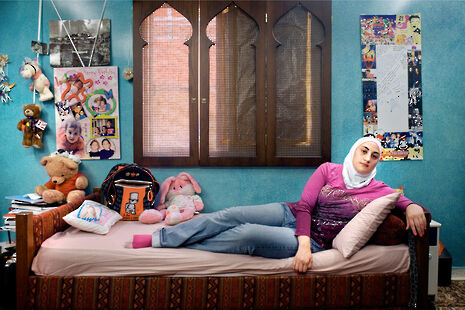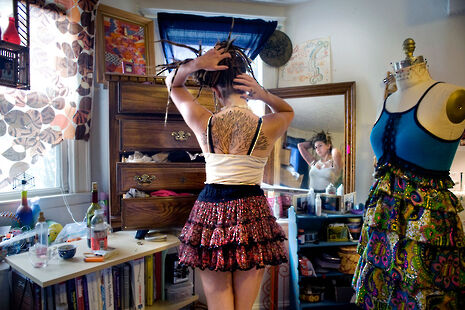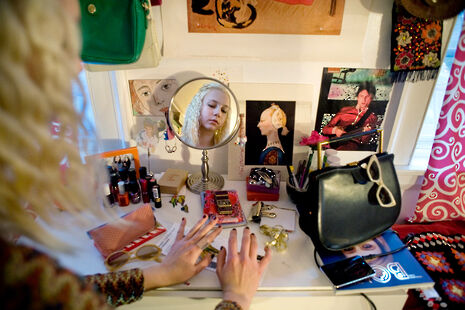Bedroom Art: snapshots of girl habitats from Boston to Beirut
Ruby Reding interviews photgrapher Rania Matar, discussing her documentation of girls’ bedroom-spaces in the US, Lebanon and in refugee camps

“The room will be the first cocoon a girl creates for herself, of herself. It is the place she first attempts self-expression onto an environment. The development of a room shows the progress: pink gives way to glitter, stuffed animals to figurines. Pictures of animals are replaced by pictures of people and with objects no longer selected by a parent. Then to these she adds her own creations and soon the walls are taken over, and the closets, and the bed.”
These are lines from photographer Rania Matar’s 2012 book. The book and project feature pictures of girls from Lebanon, refugee camps and the US. The photographs stood out to me for their modern relevance and yet also for their transporting qualities – transcending geographical and temporal boundaries. She has had countless solo exhibitions and has published three books, the latest of which is L’Enfant Femme. Matar herself emphasises that her work intends to capture a succinct universality. I caught up with her over a crackly Skype call from Boston.
We talked everything from news representations of the Middle East, to her own bedroom, to feminism. She is without pretence or egotism, but instead radiates a friendly warmth and eagerness to talk.
“It’s the one space in the world where girls can be in control”
I asked her about the bedroom as a chosen interior – she said that the setting didn’t originally shape her project, but that instead it sprang from her daughter transforming. Bedrooms started to interest Matar because “it’s the one space in the world where girls can be in control”. Control is displayed through the way the girls in her portraits personalise their spaces – some have a religious cross on their wall, one has a Dora the explorer sticker, one has a Pulp Fiction poster.

What struck me also is the awareness and self-consciousness pictured in the girls’ stares and glances. This is something common to each and every girl featured in the series – whether they are in a refugee camp or in the US. In all of the girls’ rooms, Matar talked about the bedroom as a place were “there were two connections to the outside world... one is the mirror that she’s looking at, where she’s deciding how to represent herself… and the other one is the computer, the connection to the outside world”.
The presence of digital space is something I was curious to ask about. Matar said that often in refugee camps they have computers and this is how girls can reach the outside from inside – she could feel technology’s presence in most rooms, but said that it’s not yet replacing the physical space – and that proved comforting. Perhaps the self-conscious poses in the portraits are telling of selfie culture – where we are used to having control over the way an image represents us.
“It’s interesting with the digital space, you’re putting on a little bit of an identity, you’re very aware of what you put on there, and often you portray what people want to see, but in your room… you’re still kind of are who you are.” This rings true in Matar’s photographs – which have a modern realism and vulnerable frankness. We are asked to believe in the authenticity of these girls – and to feel their sisterhood.
I was intrigued to hear that perhaps ‘room’ is more applicable here than ‘bedroom’ – as some of the rooms where the girls were photographed are shared rooms, living rooms. It’s important to recognise having private and personal space as a great privilege, even though Matar’s work asks us to see the similarities over the differences.
“The girls find a place to personalise, whether it’s their closet or the wall behind them, or something very subtle”
“A lot of these girls in the refugee camp – none of the spaces are their own bedrooms, they share a space. The space becomes the bedroom at night and then they unroll the futons and they become living rooms during the day, but I found that the girls find a place to personalise, whether it’s their closet or the wall behind them, or something very subtle – where they make it their own habitat, without it being, really, their own bedroom… it’s like the nesting instinct.”

It’s refreshing to remember this contradiction: we are all humans, we all feel self-conscious, we all relate to personal and private space, we decorate our space – but we don’t all have the privilege of a room of one’s own.
Given the female-focussed nature of her work, I couldn’t resist the urge to ask Matar if she would call herself a feminist. “The work, I do it for very personal reasons, and not for feminist reasons, but now if I’m able to give a voice to women – and especially women from the Middle East – then let me go for it.”
More than assigning these women voices, she is challenging the cyclical stereotypes that we are fed so much in the current xenophobic, political climate, in sensationalist images of Middle Eastern and Muslim women and girls in war-stricken climates.
“People have a vision of what you should look like, and how you should dress and how you should behave if you’re from the Middle East… and that’s wrong. So for me the work is political without being overtly political.”
“I realised I was exactly those girls 25 years earlier, living in a different country, in a different culture… but I was the same.”
Matar’s photographs are predominately autobiographical – she grew up in Lebanon and then moved to the US, where she raised her four children. But Matar is also happy for the work to take on new meanings. It is first and foremost personal and artistic, but it can be political, sociological, feminist; it’s these kaleidoscopic nuances that capture the common feeling of being a girl in her room.
Keep updated on her powerful exhibitions and projects at raniamatar.com
 News / Night Climbers call for Cambridge to cut ties with Israel in new stunt15 April 2024
News / Night Climbers call for Cambridge to cut ties with Israel in new stunt15 April 2024 News / Police to stop searching for stolen Fitzwilliam jade17 April 2024
News / Police to stop searching for stolen Fitzwilliam jade17 April 2024 News / Cambridge University cancer hospital opposed by environmental agency12 April 2024
News / Cambridge University cancer hospital opposed by environmental agency12 April 2024 Interviews / In conversation with Dorothy Byrne1 March 2024
Interviews / In conversation with Dorothy Byrne1 March 2024 Interviews / ‘It fills you with a sense of awe’: the year abroad experience17 April 2024
Interviews / ‘It fills you with a sense of awe’: the year abroad experience17 April 2024


